Jiamin Wang
Affordance-R1: Reinforcement Learning for Generalizable Affordance Reasoning in Multimodal Large Language Model
Aug 08, 2025Abstract:Affordance grounding focuses on predicting the specific regions of objects that are associated with the actions to be performed by robots. It plays a vital role in the fields of human-robot interaction, human-object interaction, embodied manipulation, and embodied perception. Existing models often neglect the affordance shared among different objects because they lack the Chain-of-Thought(CoT) reasoning abilities, limiting their out-of-domain (OOD) generalization and explicit reasoning capabilities. To address these challenges, we propose Affordance-R1, the first unified affordance grounding framework that integrates cognitive CoT guided Group Relative Policy Optimization (GRPO) within a reinforcement learning paradigm. Specifically, we designed a sophisticated affordance function, which contains format, perception, and cognition rewards to effectively guide optimization directions. Furthermore, we constructed a high-quality affordance-centric reasoning dataset, ReasonAff, to support training. Trained exclusively via reinforcement learning with GRPO and without explicit reasoning data, Affordance-R1 achieves robust zero-shot generalization and exhibits emergent test-time reasoning capabilities. Comprehensive experiments demonstrate that our model outperforms well-established methods and exhibits open-world generalization. To the best of our knowledge, Affordance-R1 is the first to integrate GRPO-based RL with reasoning into affordance reasoning. The code of our method and our dataset is released on https://github.com/hq-King/Affordance-R1.
STAGE: A Stream-Centric Generative World Model for Long-Horizon Driving-Scene Simulation
Jun 16, 2025Abstract:The generation of temporally consistent, high-fidelity driving videos over extended horizons presents a fundamental challenge in autonomous driving world modeling. Existing approaches often suffer from error accumulation and feature misalignment due to inadequate decoupling of spatio-temporal dynamics and limited cross-frame feature propagation mechanisms. To address these limitations, we present STAGE (Streaming Temporal Attention Generative Engine), a novel auto-regressive framework that pioneers hierarchical feature coordination and multi-phase optimization for sustainable video synthesis. To achieve high-quality long-horizon driving video generation, we introduce Hierarchical Temporal Feature Transfer (HTFT) and a novel multi-stage training strategy. HTFT enhances temporal consistency between video frames throughout the video generation process by modeling the temporal and denoising process separately and transferring denoising features between frames. The multi-stage training strategy is to divide the training into three stages, through model decoupling and auto-regressive inference process simulation, thereby accelerating model convergence and reducing error accumulation. Experiments on the Nuscenes dataset show that STAGE has significantly surpassed existing methods in the long-horizon driving video generation task. In addition, we also explored STAGE's ability to generate unlimited-length driving videos. We generated 600 frames of high-quality driving videos on the Nuscenes dataset, which far exceeds the maximum length achievable by existing methods.
Vaiage: A Multi-Agent Solution to Personalized Travel Planning
May 16, 2025Abstract:Planning trips is a cognitively intensive task involving conflicting user preferences, dynamic external information, and multi-step temporal-spatial optimization. Traditional platforms often fall short - they provide static results, lack contextual adaptation, and fail to support real-time interaction or intent refinement. Our approach, Vaiage, addresses these challenges through a graph-structured multi-agent framework built around large language models (LLMs) that serve as both goal-conditioned recommenders and sequential planners. LLMs infer user intent, suggest personalized destinations and activities, and synthesize itineraries that align with contextual constraints such as budget, timing, group size, and weather. Through natural language interaction, structured tool use, and map-based feedback loops, Vaiage enables adaptive, explainable, and end-to-end travel planning grounded in both symbolic reasoning and conversational understanding. To evaluate Vaiage, we conducted human-in-the-loop experiments using rubric-based GPT-4 assessments and qualitative feedback. The full system achieved an average score of 8.5 out of 10, outperforming the no-strategy (7.2) and no-external-API (6.8) variants, particularly in feasibility. Qualitative analysis indicated that agent coordination - especially the Strategy and Information Agents - significantly improved itinerary quality by optimizing time use and integrating real-time context. These results demonstrate the effectiveness of combining LLM reasoning with symbolic agent coordination in open-ended, real-world planning tasks.
DenseGNN: universal and scalable deeper graph neural networks for high-performance property prediction in crystals and molecules
Jan 05, 2025Abstract:Generative models generate vast numbers of hypothetical materials, necessitating fast, accurate models for property prediction. Graph Neural Networks (GNNs) excel in this domain but face challenges like high training costs, domain adaptation issues, and over-smoothing. We introduce DenseGNN, which employs Dense Connectivity Network (DCN), Hierarchical Node-Edge-Graph Residual Networks (HRN), and Local Structure Order Parameters Embedding (LOPE) to address these challenges. DenseGNN achieves state-of-the-art performance on datasets such as JARVIS-DFT, Materials Project, and QM9, improving the performance of models like GIN, Schnet, and Hamnet on materials datasets. By optimizing atomic embeddings and reducing computational costs, DenseGNN enables deeper architectures and surpasses other GNNs in crystal structure distinction, approaching X-ray diffraction method accuracy. This advances materials discovery and design.
* DenseGNN optimizes computational efficiency and accuracy in predicting material properties using DCN, HRN, and LOPE. It enhances transferability and overcomes over-smoothing, enabling deep architectures. Performance improvements on JARVIS-DFT, Materials Project, and QM9 datasets advance materials discovery and design
RealDex: Towards Human-like Grasping for Robotic Dexterous Hand
Feb 21, 2024



Abstract:In this paper, we introduce RealDex, a pioneering dataset capturing authentic dexterous hand grasping motions infused with human behavioral patterns, enriched by multi-view and multimodal visual data. Utilizing a teleoperation system, we seamlessly synchronize human-robot hand poses in real time. This collection of human-like motions is crucial for training dexterous hands to mimic human movements more naturally and precisely. RealDex holds immense promise in advancing humanoid robot for automated perception, cognition, and manipulation in real-world scenarios. Moreover, we introduce a cutting-edge dexterous grasping motion generation framework, which aligns with human experience and enhances real-world applicability through effectively utilizing Multimodal Large Language Models. Extensive experiments have demonstrated the superior performance of our method on RealDex and other open datasets. The complete dataset and code will be made available upon the publication of this work.
Towards Imperceptible Adversarial Image Patches Based on Network Explanations
Dec 10, 2020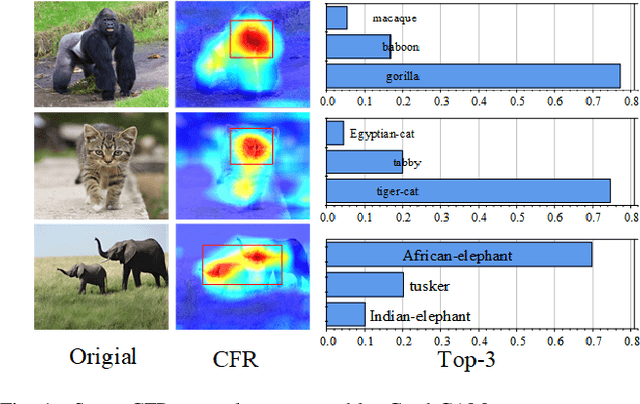
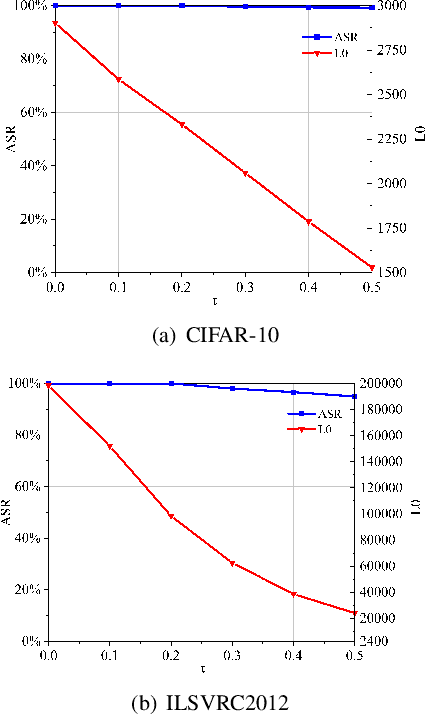
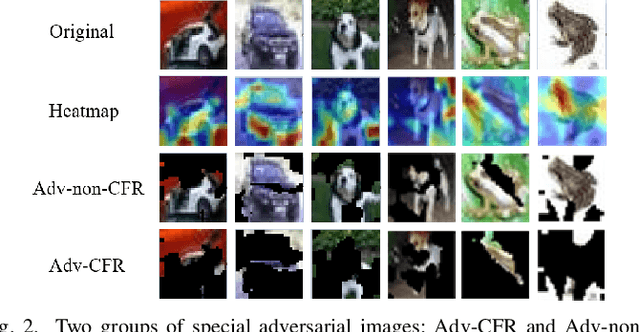
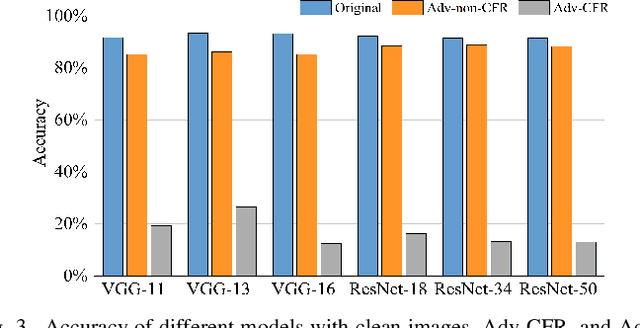
Abstract:The vulnerability of deep neural networks (DNNs) for adversarial examples have attracted more attention. Many algorithms are proposed to craft powerful adversarial examples. However, these algorithms modifying the global or local region of pixels without taking into account network explanations. Hence, the perturbations are redundancy and easily detected by human eyes. In this paper, we propose a novel method to generate local region perturbations. The main idea is to find the contributing feature regions (CFRs) of images based on network explanations for perturbations. Due to the network explanations, the perturbations added to the CFRs are more effective than other regions. In our method, a soft mask matrix is designed to represent the CFRs for finely characterizing the contributions of each pixel. Based on this soft mask, we develop a new objective function with inverse temperature to search for optimal perturbations in CFRs. Extensive experiments are conducted on CIFAR-10 and ILSVRC2012, which demonstrate the effectiveness, including attack success rate, imperceptibility,and transferability.
EI-MTD:Moving Target Defense for Edge Intelligence against Adversarial Attacks
Oct 11, 2020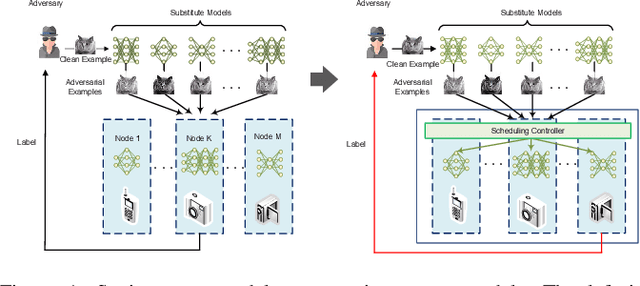
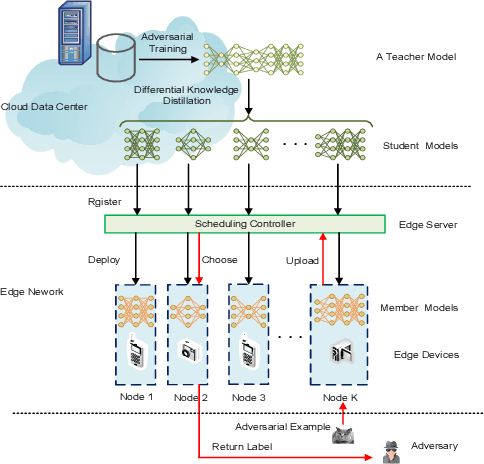
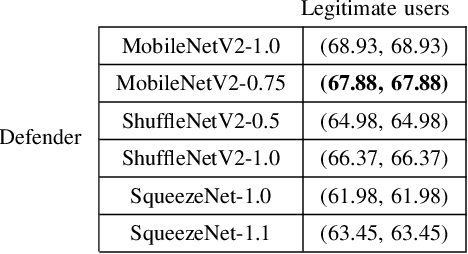
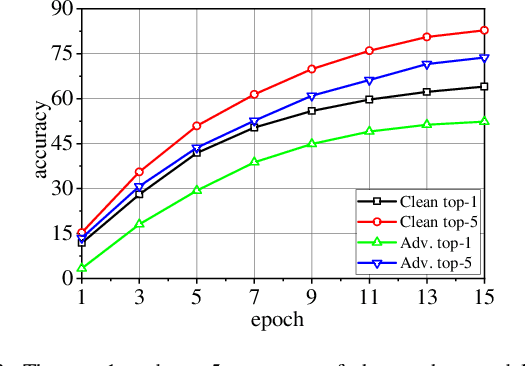
Abstract:With the boom of edge intelligence, its vulnerability to adversarial attacks becomes an urgent problem. The so-called adversarial example can fool a deep learning model on the edge node to misclassify. Due to the property of transferability, the adversary can easily make a black-box attack using a local substitute model. Nevertheless, the limitation of resource of edge nodes cannot afford a complicated defense mechanism as doing on the cloud data center. To overcome the challenge, we propose a dynamic defense mechanism, namely EI-MTD. It first obtains robust member models with small size through differential knowledge distillation from a complicated teacher model on the cloud data center. Then, a dynamic scheduling policy based on a Bayesian Stackelberg game is applied to the choice of a target model for service. This dynamic defense can prohibit the adversary from selecting an optimal substitute model for black-box attacks. Our experimental result shows that this dynamic scheduling can effectively protect edge intelligence against adversarial attacks under the black-box setting.
 Add to Chrome
Add to Chrome Add to Firefox
Add to Firefox Add to Edge
Add to Edge